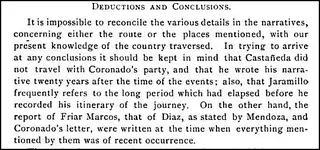Not Peralta
Bronze Member
- Joined
- Mar 23, 2013
- Messages
- 2,167
- Reaction score
- 3,066
- Golden Thread
- 0
- Primary Interest:
- All Treasure Hunting
- #261
Thread Owner
you just dont understand.np
NP,
... Look for title in the Index for; Chichilticalli, by Samuel O.L. Potter, see page 257. It is very important that you read this eye witness account.
One can actually go to this area and witness this anomaly in person. ...
Ellie B

Ellie B,
With all due respect what he said and what I saw makes more sense than what you say. The old weathered copy of the H/P map he had was well used.
Good luck with your theory.
Tom
Springfield,
I agree with you 100%. I too do not believe that this structure is Chichilticalli. That honor belongs to the big house known as Casa Grande. Why Potter's story is important is that he shares with us the anomaly located in the Sierra Ancha specifically the red castle located high up on the cliff.
Frere Mark de Nice by Michael Nallino (2010) IMHO has written the best book about this subject. Unfortunately it is written in French. ....
That may be so, at least we know that Kino was at Casa Grande. I don't believe anyone has made much of an argument that Marcos or the Coronado expedition saw the site.
I agree Nallino is a good source, even though there are major questions surrounding Marcos still unexplained, including the 'missing time block' assumed to have occurred in 1539 when he was supposedly at Zuni but apparently was not. I have a couple of English translations of Nallino's papers I can send to you if you don't already have them (A Supposed Franciscan Exploration of Arizona in 1538: The Origins of a Myth, and Fray Marcos de Niza: In Pursuit of Franciscan Utopia in Americas).
Springfield and Ellie Baba,
I'm kinda glad you brought this subject up on my thread. A few questions: When Coronado's expidition had to split up because they found out the land ahead of them could not sustain their large party, they were entering a cactus bearing land. True or False? #2 The Spanish ship resupplying Coronado's party thought they were half way up the Grand Canyon, they didn't think they could go any further with their ships. Later it was found out that they weren't half way up the Grand Canyon but were in fact at the junction of the Gila and the Colorado rivers. That's where they dropped Coronado's supp;ies. True or False? #3 The Yuman Indians told them, when asked by the Spaniards, that the rest of the men went "UP" the river in the smaller boats. True or False?
NP
To Springfield and Ellie and Real del Tayopa,
Since Ellie thinks I need to learn more about what I'm talking about, maybe you'll find this interesting. Just happened to have it laying around. Enjoy, NPView attachment 784518
Springfield,
..... Frey Marcos took a wrong turn and had taken another route. Kino understood the so called error for Frey Marcos knew exactly where he was going as he was a seasoned navigator. He was hand picked for this job. Kino understood the History as Herrera had written it in the four volumes for the King of Spain. Father Kino also made a statement that the Seven Cities began at the Casa Grande on the Gila and that is why Frey Marcos made it a point to visit this spot (check out the latitude and longitude of the Casa Grande, a major clue). Father Kino was commissioned to produce a map that would define the Pimeria Alta region for the next 400 years. A drop of water for a dry parched tongue.
The plot thickens,
Ellie Baba
Springfield and Ellie Baba,
I'm kinda glad you brought this subject up on my thread. A few questions: When Coronado's expidition had to split up because they found out the land ahead of them could not sustain their large party, they were entering a cactus bearing land. True or False? #2 The Spanish ship resupplying Coronado's party thought they were half way up the Grand Canyon, they didn't think they could go any further with their ships. Later it was found out that they weren't half way up the Grand Canyon but were in fact at the junction of the Gila and the Colorado rivers. That's where they dropped Coronado's supp;ies. True or False? #3 The Yuman Indians told them, when asked by the Spaniards, that the rest of the men went "UP" the river in the smaller boats. True or False?
NP
To Springfield and Ellie and Real del Tayopa,
Since Ellie thinks I need to learn more about what I'm talking about, maybe you'll find this interesting. Just happened to have it laying around. Enjoy, NPView attachment 784518

To Springfield and Ellie and Real del Tayopa,
Since Ellie thinks I need to learn more about what I'm talking about, maybe you'll find this interesting. Just happened to have it laying around. Enjoy, NPView attachment 784518
